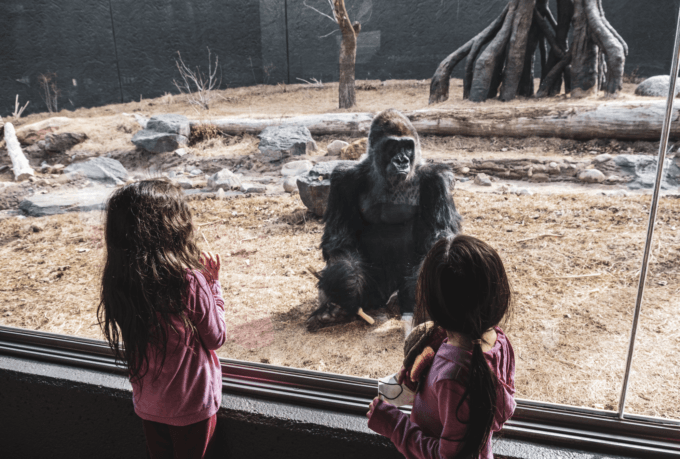Photo by Alan Rodriguez
I remember the first time I saw my daughter pointing. We were at a neighborhood playgroup, a daily gathering place for toddlers and their parents, and 12-month-old Tessa pointed to a painting of a koala on the wall. I looked at her in surprise, almost shouting with joy. Over the next days and weeks, she pointed out with increasing frequency things that interested her and, more importantly, things that she wanted to share with me. Every time she does this I look at her in amazement. Other parents thought I was crazy.
Early in my life, I was a primatologist studying the behavior and communication of capuchin monkeys, chimpanzees, and bonobos (the latter being relatives of chimpanzees but a unique species with very different behavioral characteristics). I ended up specializing in great ape gestures and multimodal communication. Apes have greater cortical control of their hands than other primates, and they use their hands to gesture to each other. In addition to gestures, apes communicate using facial expressions and vocalizations, and sometimes they use all three modalities simultaneously (just like humans), hence the term multimodal communication.
One thing I always look for when collecting data is pointing; this is rare among the social chimpanzees I study who live outdoors, and the few times I observed it, it was a big deal. To be sure, chimpanzees have other ways of signaling to each other what they want, but pointing with your index finger isn’t usually one of them. When I see this all-too-common behavior in my own children, it makes me appreciate the complexity (and sociality) of human cognition even more.
Primatologists study our closest living relatives for a variety of reasons, essentially to learn more about their lives (diet, habitat, mating patterns, genetics), to understand how they interact with their environment, and to shed light on our relationship with apes The last common ancestor might have been like. One of the enduring mysteries of human evolution is how much of our behavior and cognition is unique to humans, and how much is found in living primates. This is the focus of my research.
When I watch in amazement as my daughter points to the koala drawing and looks at me, what other parents don’t know is that I’m amazed at how often human toddlers point, and that means kids point It’s about sharing attention, not just getting stuff. This distinction is called declarative vs. imperative pointing Hey mom, look at that cool thing over there! Instead of giving me that piece of candy on the shelf. Pointing is considered a sign of communication, language development, and joint attention (when one person wants another person to pay attention to the same thing she is looking at), and neurotypical toddlers do this all the time (not pointing is a sign of autism) disease).
In addition to my daughter Tessa, I have a son Eli who is two years younger. Like all siblings, they are obsessed with fairness (I don’t believe any parent who says their child is unfair). If a child gets a cookie that’s even one millimeter larger than the other kids, everything falls apart. You can try your best to explain to them why one cookie is bigger, but the kids won’t eat it. We tend to think of this concern for fairness as uniquely human, but my lab colleague Sarah Brosnan and our PhD advisor Frans de Waal 20 This view was corrected 20 years ago in a landmark study aptly named Capuchins Reject Unequal Pay. In this study, two brown capuchin monkeys (highly intelligent South American monkeys) worked side by side on a token exchange task. As a reward, everyone received a cucumber slice. Everything is peaceful when the monkeys get the same pay for doing the same work. This peace is quickly broken when one person receives a grape (more desirable than a cucumber) and the other person still gets a cucumber. When the monkey became so satisfied with a cucumber that he lost it as soon as he saw another grape; he actually threw it out of his enclosure in what I freely admit was an anthropomorphic sense of rage . Capuchins do reject unequal pay.
When I see my kids arguing over the fact that one backpack takes up an inch more space on the side of the car than the other, I try to remember that this is evolutionarily ancient behavior that ensures cooperation is good for our species . All else being equal, why would we care that others get more than we do? In the long run, we will be more willing to cooperate if we are confident that everyone puts in an equal amount of work and receives similar compensation. I tell my kids about this but for some reason they don’t act like rational beings and rarely argue. But when they discovered that cooperation could bring them huge rewards (like stepping on each other’s shoulders to get to the candy I thought I’d cleverly hidden), they became my shining example of evolutionary continuity. I feel very proud.
Seeing my children through primate glasses has given me an ongoing perspective on raising them. When they lose their temper, argue over the last piece of cake, or try to get my attention through gestures, these glasses allow me to step back and recognize the broader purpose of their behavior (I hope!). This perspective also helps me feel another level of connection. Remembering that we are all one primate family makes the wilderness of human parenting much more manageable and fun.
This article was created byHumanities Bridge.
#Raising #hairless #primates
Image Source : www.counterpunch.org
